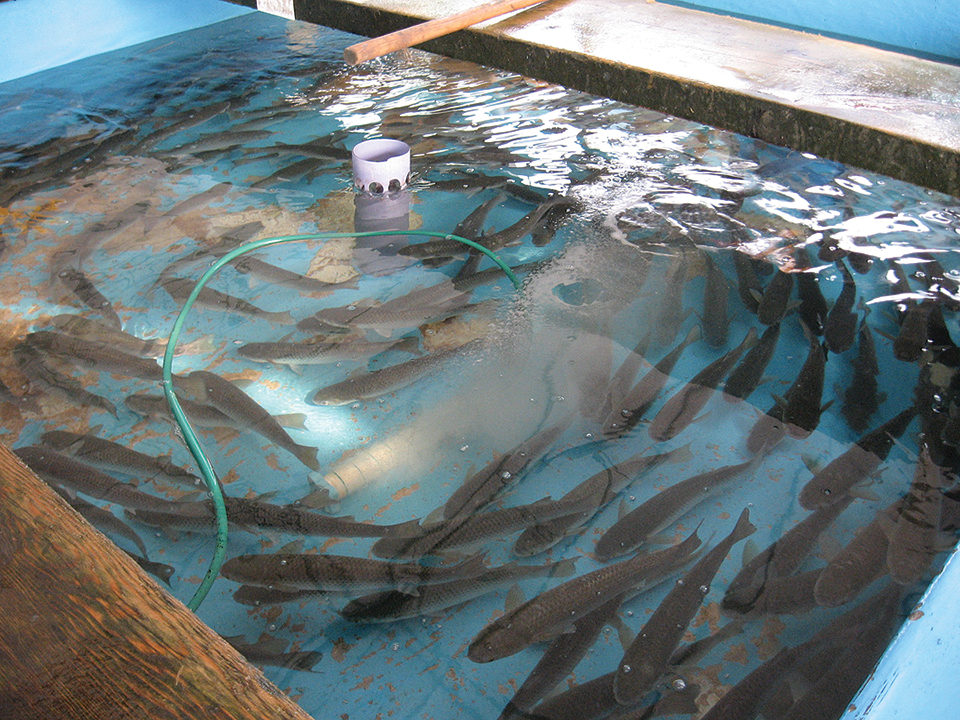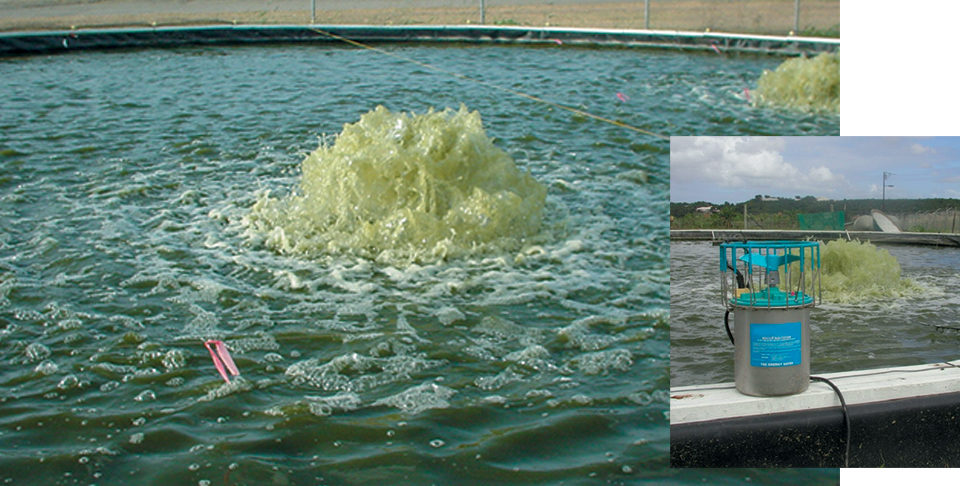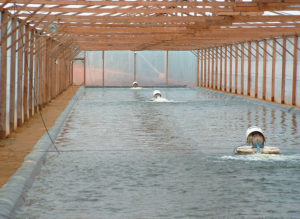
The need for aeration and mixing in biofloc technology is well documented. Not only is dissolved oxygen needed for respiration by the aquatic animals in production, but it is also required for aerobic breakdown of organics in the water column, conversion of ammonia to nitrite and then to nitrate by the biofloc (nitrification), and nighttime respiration by algae. The overall whole pond respiration rate can be significant in biofloc systems.
In addition to the requirement for aeration, mixing is also very important, as the floc particles must remain in suspension in the water column. Maintaining proper water flow velocity is essential for optimizing biofloc systems and keeping microorganisms suspended in the water column. An additional benefit of aeration and mixing is the removal of gases from the water column, which can have a great effect on overall water quality.
Aeration in biofloc systems
Despite all that is known regarding aeration efficiency and pond dynamics, there is still a need for progress in improving sizing and design for applications in biofloc systems. In 2003, author Peterson discussed the need for more efficient energy management of pond aeration and suggested that in many cases, energy use for production is wasteful. Production economics could be optimized by using mixing at times when dissolved-oxygen (D.O.) levels are high and aeration when D.O. levels are low.
A wide variety of aeration and mixing systems has been used in biofloc systems. Diffused air systems are more often used in smaller applications like tanks and basins, while surface aerators are more widely used in grow-out ponds. Combinations of these aeration systems have also been applied in many locations.
Diffused air
Diffused-air systems include air compressors, blowers or air pumps, and many types of diffusers. Piping or a submerged air hose connects the air source to diffusers made of silica stones, tubing or porous hose. Some diffused-air systems use secured, floating airlines that stretch into or across the pond surface. In some cases, air stones are suspended in the water column by plastic tubing or hoses connected to a floating air line.
Diffuser systems work primarily by moving deeper waters to the surface and creating a constant mixing or destratifying effect. Secondarily, oxygen is transferred into the water column as the air bubbles rise to the surface. By keeping the pond water constantly mixed, a diffused air system may prevent low dissolved-oxygen emergencies from occurring.
Oxygen transfer efficiency increases in diffused-air systems with pond depth and the amount of time the air bubbles remain in the water column. As a result, diffused-air systems are more efficient in deeper water than in shallow ponds.
For biofloc system applications, a range of diffuser types based on bubble diameter is available, although the size of bubble is not always well defined. In fine-pore diffusers, bubble size diameter is 0.5 to 2.0 mm. Medium-pore diffusers produce bubbles of 1- to 3-mm diameter, while bubbles from coarse diffusers are generally greater than 5 mm in diameter.
There is a trade-off between using smaller bubbles that create less vertical mixing of the water column and large bubbles that require less pressure but are less efficient in terms of oxygen transfer. Fine-pore diffusers require higher air pressure and clog more frequently than coarse-bubble diffusers, but they are more efficient in terms of oxygen transfer. Periodic cleaning of diffusers may be required, particularly in saltwater applications where biofouling can be a serious problem.
High-efficiency rubber/polyethylene tubing is a popular diffuser material made from linear low-density polyethylene and rubber from recycled car tires. The porous tubing is similar to soaker hose used in irrigation. However, the aeration product is specifically designed for good air flow and small bubbles.
Soaker hoses have fewer and larger pores that require higher air pressure to operate. The rubber poly tubing provides a high volume of fine bubbles. It is very effective in mixing due to the strong vertical flow current produced with proper system design.

Surface aeration
Surface aerators operate at the water surface of the pond or tank. They usually float, although some can be mounted on a structure near the surface of the water column. Surface aerators operate by mixing air or oxygen into the water or moving water into the air.
Typical surface aerators used in biofloc applications include vertical pump aerators, propeller aspirator pump aerators and paddlewheel aerators. The most common aerators are paddlewheels, though many farms use a combined approach with both paddlewheel and aspirating aerators.
Vertical pump aerators
Vertical pump aerators are typically used for aeration of small, shallow ponds. These aerators usually have a submerged electric motor that is suspended inside a float. A propeller located just below the water surface moves water vertically upward.
Vertical pump aerators provide good localized oxygen transfer in the vicinity of the aerator, but may not affect D.O. concentrations laterally in large ponds. In addition, they do not destratify deep ponds, as only the surface water is drawn upward. Some units use a draft tube to draw water from greater depths, but reduces aeration efficiency.
Vertical pump aerators are not good circulators, as most of their energy works vertically to force water up into the air. These aerators have been used in tanks or shallow ponds and may be used in combination with other aerators that provide horizontal circulation.
Propeller-aspirator pump aerators

The propeller-aspirator pump aerator is a floating surface unit that uses an electric motor and a hollow, rotating shaft that can be adjusted to operate at various angles in the water column. A propeller attached to the end of the shaft moves water past the end of the hollow shaft, creating a vacuum.
This vacuum draws air through holes in the shaft from above the water surface. The air is injected into the water and moved horizontally by the propeller below the water surface. Air bubbles are driven to the bottom of the pond while water is moved horizontally away from the aerator.
Propeller-aspirator pump aerators are very good mixing devices. They are particularly useful in pond destratification. The systems circulate and uniformly mix oxygen throughout the pond, producing fine bubbles smaller than 2.2 mm in diameter.
(Editor’s Note: This article was originally published in the September/October 2010 print edition of the Global Aquaculture Advocate.)
Now that you've finished reading the article ...
… we hope you’ll consider supporting our mission to document the evolution of the global aquaculture industry and share our vast network of contributors’ expansive knowledge every week.
By becoming a Global Seafood Alliance member, you’re ensuring that all of the pre-competitive work we do through member benefits, resources and events can continue. Individual membership costs just $50 a year. GSA individual and corporate members receive complimentary access to a series of GOAL virtual events beginning in April. Join now.
Not a GSA member? Join us.
Authors
-
Gary Rogers, Ph.D., P.E.
Aquatic Eco-Systems, Inc.
2395 Apopka Boulevard
Apopka, Florida 32703 USA[109,111,99,46,111,99,101,99,105,116,97,117,113,97,64,114,121,114,97,103]
-
Yoshi Hirono
Aquatic Eco-Systems, Inc.
2395 Apopka Boulevard
Apopka, Florida 32703 USA
Tagged With
Related Posts

Aquafeeds
Biofloc and clear-water RAS systems: a comparison
This study compared two types of indoor, shrimp culture systems: clear-water RAS and biofloc systems. Clearwater RAS had the edge in water quality, but shrimp in the biofloc treatment had a higher feed conversion ratio.

Aquafeeds
Biofloc consumption by Pacific white shrimp postlarvae
The stable isotopes technique with δ13C and δ15N can be used to determine the relevance of different food sources to shrimp feeding during the pre-nursery phase of Litopenaeus vannamei culture. During this trial, different types of commercial feed, microalgae, Artemia sp. nauplii and bioflocs were used as food sources.

Aquafeeds
Biofloc systems viable for tilapia production
Well-designed and managed biofloc technology systems are a viable alternative for production of various species like tilapia, to increase feed efficiency by lowering aquafeed protein requirements and to help reduce or eliminate effluent discharges.

Health & Welfare
Biofloc technology holds potential for carnivorous fish species
Juvenile carnivorous African catfish performed well in biofloc-based systems, which could help produce better quality and more disease-resistant seed of this important aquaculture species and support the expansion of African catfish farming industry.


